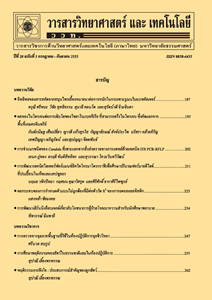การผลิตเม็ดบีดส์น้ำเสาวรสด้วยเทคนิครีเวิร์สสเฟียริฟิเคชัน
Main Article Content
Abstract
Reverse spherification is a technique use in modernist cuisine, which is termed as molecular gastronomy. It is a technique that is now gaining more importance in the modern food market. The present study aims to find out the optimum conditions for production of passion fruit beads by reverse spherification. The influences of calcium lactate concentration (0.5 and 1.0 g/100g) and gelation time (5 and 10 mins) were evaluated. Results showed that the optimum condition was 1.0 g/100g of calcium lactate solution and 10 mins of gelation time. The beads soaked in calcium lactate solution were decreased in diameter (p < 0.05), which average diameter of beads was in the range of 6.70-6.87 mm. As the concentration of calcium lactate increased, the hardness increased but the swelling capacity decreased. The effect of fresh and used sodium alginate solutions and gelling temperature (5 and 25 ˚C) were also studied. Utilization of fresh sodium alginate solution at 5 ˚C rendered the bead with greater in, than other treatments with lowest in bead swelling (p < 0.05).
Keywords: reverse spherification; passion fruit; alginate; beads; molecular gastronomy
Article Details
References
[2] ธงชัย เนมขุนทด, 2534, แพสชั่นฟรุ๊ต, โครงการหนังสือเกษตรชุมชน, สำนักพิมพ์เรืองแสงการพิมพ์, กรุงเทพฯ, 72 น.
[3] Mohy Eldin, M.S., Kamoun, E.A., Sofan, M.A. and Elbayomi, S.M., 2014, L-arginine grafted alginate hydrogel beads: a novel pH-sensitive system for specific protein delivery, Arab. J. Chem. 8: 355-365.
[4] Tsai, F.H., Chiang, P.Y., Kitamura, Y., Kokawa, M. and Islam, M.Z., 2017, Producing liquid-core hydrogel beads by reverse spherification: Effect of secondary gelation on physical properties and release characteristics, J. Food Hydrocoll. 62: 140-148.
[5] Sinha, P., Ubaidulla, U., Hasnain, M.S., Nayak, A.K. and Rama, B., 2015, Alginate-okra gum blend beads of diclofenac sodium from aqueous template using ZnSO4 as a cross-linker, Int. J. Biol. Macromol. 79: 555-563.
[6] Pawar, S.N. and Edgar, K.J., 2012, Alginate derivatization: A review of chemistry properties and applications, J. Biomat. 33: 3279-3305.
[7] Hu, S.H., Tsai, C.H., Liao, C.F., Liu, D.M. and Chen, S.Y., 2008, Controlled rupture of magnetic polyelectrolyte microcapsules for drug delivery, Langmuir 24: 11811-11818.
[8] Phawaphuthanon, N., Behnam, S., Koo, S.Y., Pan, C.H. and Chung, D., 2014, Characterization of core-shell calcium-alginate macrocapsules fabricated by electro-coextrusion, Int. J. Biol. Macromol. 65: 267-274.
[9] Correia, C.R., Sher, P., Reis, R.L. and Mano, J.F., 2013, Liquified chitosan-alginate multilayer capsules incorporating poly (l-lactic acid) microparticles as cell carriers, Soft Matter. 9: 2125-2130.
[10] Blandino, A., Macías, M. and Cantero, D., 1999, Formation of calcium alginate gel capsules: Influence of sodium alginate and CaCl2 concentration on gelation kinetics, J. Biosci. Bioeng. 88: 686-689.
[11] Tsai, F.H., Kitamura, Y. and Kokawa, M., 2017, Liquid-core alginate hydrogel beads loaded with functional compounds of radish by-products by reverse spherification: Optimization by response surface methodology, Int. J. Biol. Macromol. 96: 600-610.
[12] Gong, R., Li, C., Zhu, S., Zhang, Y., Du, Y. and Jiang, J., 2011, A novel pH-sensitive hydrogel based on dual crosslinked alginate/N-a glutaric acid chitosan for oral delivery of protein, Carbohyd. Polym. 85: 869-874.
[13] Belščak-Cvitanovića, A., Komesa, D., Karlovića, S., DjakovićaIgor, S., Špoljarićb, I., Mršićb, G. and Ježeka, D., 2015, Improving the controlled delivery formulations of caffeine in alginate hydrogel beads combined with pectin, carrageenan, chitosan and psyllium, Food Chem. 167: 378-386.
[14] Chan, E.S., Lee, B.B., Ravindra, P. and Poncelet, D., 2009, Prediction models for shape and size of ca-alginate macrobeads produced through extrusion-dripping method, J. Colloid Interf. Sci. 338: 63-72.
[15] Wichchukit, S., Oztop, M.H., McCarthy, M.J. and McCarthy, K.L., 2013, Whey protein/ alginate beads as carriers of a bioactive component, J. Food Hydrocoll. 33: 66-73.
[16] Messaoud, G.B., Sánchez-González, L., Jacquot, A., Probst, L. and Desobry, S., 2015, Alginate/sodium caseinate aqueous-core capsules: A pH-responsive matrix, J. Colloid and Interf. Sci. 440: 1-8.
[17] Messaoud, G.B., Sánchez-González, L., Probst, L., Jeandel, C., Arab-Tehrany, E. and Desobry, S., 2016, Physico-chemical properties of alginate/shellac aqueous-core capsules: Influence of membrane architecture on riboflavin release, Carbohyd. Polym. 144: 428-437.
[18] Bajpai, S.K. and Sharma, Sh., 2004, Investigation of swelling/degradation behaviour of alginate beads crosslinked with Ca2+ and Ba2+ ions, React. Funct. Polym. 59: 129-140.
[19] Phillips, G.O. and Williams, P.A., 2000, Handbook of Hydrocolloids, CRC press, New York.

